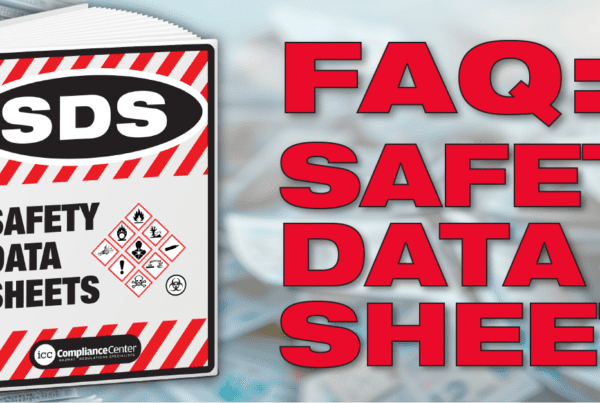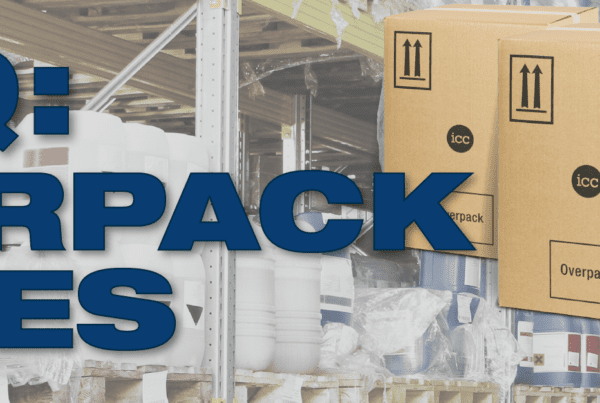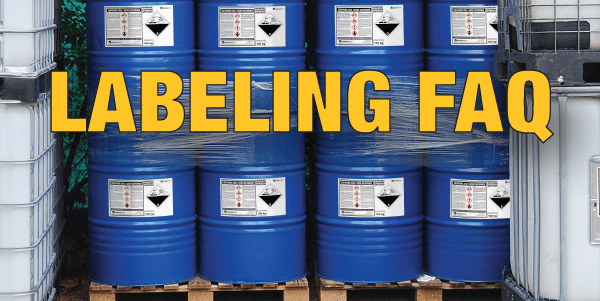Frequently asked questions about Limited Quantities.
Do the regulations for transportation of dangerous goods/hazardous materials really care about small containers? Are they actually dangerous?
Yes! Even small quantities of dangerous goods/hazardous materials will be regulated. Although less likely to cause harm to wide areas, small leaks and spills of hazardous materials can still cause harm such as fires or injuries to people exposed to them. But if you use the “limited quantity” option, you’ll find these small containers become much easier to transport.
Are all limited quantity provisions the same?
No, and that’s important to recognize. Although the basics of limited quantity shipments are spelled out in the UN Recommendations on the Transport of Dangerous Goods, each regulation may handle them differently. It’s important to know if your shipment will be transported:
- By ground in the US
- By ground in Canada
- By ground in other areas, such as Mexico or the European Union (EU)
- By air
- By international marine
Each of these situations will handle limited quantities differently.
How small is a limited quantity?
It varies! Some things (particularly very high-risk substances like severe poisons in Packing Group I) may not have a limited quantity option at all. For most substances, though, the limits may range from 100 milliliters or grams per inner receptacle up to 5 Liters or kilograms per inner. The more dangerous the substance, the smaller the limit is likely to be.
In addition, one common theme in most regulations is that these inner receptacles must be put in a sturdy outer packaging, and each completed package may not weigh more than 30 kilograms gross. However, the good news is that you can ship multiple packages as long as each one doesn’t exceed 30 kilograms – there’s no cumulative total per shipment.
The size limits can be found in:
- Under the “Transportation of Dangerous Goods Regulations” (TDG) for ground transport in Canada, you’ll find the maximum size for the inner receptacles in Column 6(a) of Schedule 1
- Under the International Maritime Dangerous Goods Code (IMDG) for ocean transport you’ll find the maximum size for the inner receptacles in Column 7(a) of the Dangerous Goods List, Volume 2, section 3.2
- In the IATA Dangerous Goods Regulations for air transport, you’ll find the maximum total per package (not inner size limit) in Column H of the List of Dangerous Goods, section 4.2. In Column G, right before this, you’ll find a “packing instruction” code, which refers you to Section 5 of the regulations. The packing instruction will include the maximum allowed size of the inner containers, as well as what type of packagings can be used for inner receptacles and the outer packaging.
- Under the US “Hazardous Materials Regulations” of Title 49, Code of Federal Regulations (49 CFR), start by finding the “Exceptions” section reference in Column 8A of the Hazardous Materials Table, section 172.101. This would refer you to a section in Part 173, which would give the main details such as the size limit for inner receptacles based on the class of the substance.
Where in the regulations can I find the details on Limited Quantities?
The basics on limited quantities can be found:
- Under Canada’s TDG in section 1.17
- Under the IATA Dangerous Goods Regulations in section 2.7
- Under the IMDG Code in Volume 2, section 3.4
- Under US regulations of 49 CFR, go to Column 8A of the Hazardous Materials Table, section 172.101. This would refer you to a section in Part 173, which would give the main details such as the size limit for inner receptacles based on the class of the substance as well as what parts of the regulations you’re excepted from. Marking for limited quantities is given in section 172.315 and when shipping papers are required in section 172.200(b)(3).
What are the benefits of shipping goods as limited quantities by surface transport?
In most regulations, there are lots of advantages! However, they can differ between regulations. In most surface regulations such as 49 CFR, TDG or the IMDG Code:
- You don’t have to use UN specification packaging. Just use packaging that’s sturdy enough that you can assume it will get where it’s going without leaking under normal conditions. (Note that some regulations will suggest it should be capable of passing a drop test and a stacking test).
- You don’t have to mark and label the package as normal dangerous goods. So, no class labels, shipping name, or UN number. Instead, each package requires a “Limited Quantity mark,” which is a diamond outline on a contrasting background, with the top and bottom blacked out. These will normally be 100 mm per side, but for smaller packages they can be reduced to 50 millimeters per side to fit.
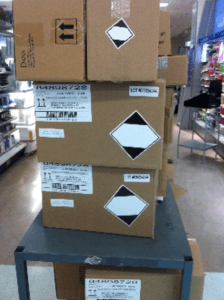
- You may not need to list them as dangerous goods on the shipping document. Some regulations differ on this – TDG and 49 CFR don’t require them to be listed as dangerous, but the IMDG Code does. Watch out for this when transporting goods by ferry.
- You will not require class placards on the vehicle or freight container (although the IMDG Code requires the limited quantity diamond to be marked on all four sides of an ocean-going container if it contains only limited quantities, no other dangerous goods).
- Most regulations will not require that you have official dangerous goods/hazardous materials training certification. However, you would still need instruction on the basics of limited quantity shipments.
- Segregation by class may not apply to limited quantities.
- Some countries may accept limited quantities by mail but not regular dangerous goods.
What about limited quantities by air? What are the advantages there?
Limited quantities can sometimes be useful for shipping by air, but it’s not as useful as it is for ground. Basically, a limited quantity going by air does not require UN specification packaging, but is subject to all other requirements, such as a Shipper’s Declaration for Dangerous Goods document, and marking and labeling as an air dangerous goods shipment. It must also be marked with the limited quantity mark in addition to all other required marks and labels. It can save you some money, and is useful where UN specification packaging may be hard to obtain.
Why do some limited quantity marks have a “Y” in the center and some don’t?
Originally, since limited quantities for air shipment had very different requirements, it was decided to give them a different limited quantity symbol, by putting the letter “Y” in the center of the mark when used for air shipment. However, since then, the rules have been relaxed. Most surface regulations, such as 49 CFR (section 172.315(a)) and TDG (section 1.17(5)), allow you to use the “Y” mark on ground shipments, while the IATA Dangerous Goods Regulations will now accept the mark without the “Y” (IATA DGR section 7.1.5.6). So, it’s your call!
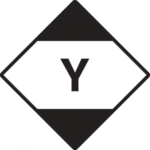
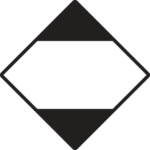
What I’m shipping is really, REALLY small. Like hardly visible. Do I still have to ship it as a limited quantity?
Fortunately, if your receptacles contain not more than 1 milliliter of liquid or 1 gram of solid substance, you may not have to even ship it as a limited quantity. Most regulations have what are called “de minimis” provisions. These are for amounts of dangerous goods/hazardous materials so small that they are very unlikely to hurt anyone even in a spill. These provisions can be found in:
- TDG – section 1.17.1(8)
- 49 CFR – section 173.4b
- IMDG Code – section 3.5.1.4
- IATA Dangerous Goods Regulations – section 2.6.10
What sort of substances can’t use limited quantities?
Unfortunately, some substances can’t be shipped as limited quantities at all. As always, this can vary from one regulation to another. But things which don’t normally have a limited quantity option include:
- Substances with a high degree of danger, especially if they’re in Packing Group I.
- Substances in cylinders such as compressed gases (although they may be permitted by some regulations)
- Explosive substances and articles in Class 1
- Lithium batteries (lithium batteries have an exception based on their power, not on the container size like limited quantities)
- For air shipment under the IATA Dangerous Goods Regulations, things which don’t require UN specification packaging don’t get a limited quantity exception because limited quantities by air only except you from UN packaging. It just wouldn’t be necessary.
Can radioactive substances be transported as limited quantities?
This is complicated. A package that contains a small amount of radioactive material may be able to be shipped as UN2910, “Radioactive material, excepted package – limited quantity of material.” However, this isn’t the sort of limited quantity we’ve been discussing. It’s a special provision for radioactive substances called “excepted packages.” It doesn’t work exactly like limited quantities, but it will give you relief from most of the requirements of the regulations. For example, the package won’t require normal dangerous goods documentation, but it will need at least a minimal notation. Packages don’t have to be fully marked and labelled, but will require the UN number on the outside surface. (For air shipment under the IATA Dangerous Goods Regulations, there is a special label to display the number. Otherwise, it can just be marked directly on the package.) UN2910 would not require a normal limited quantity mark, however. Consult the regulations appropriate to your country and mode to see how they handle radioactive substances in excepted packages.
What are consumer commodities, and how are they different from limited quantities?
In earlier versions of some regulations there was a distinction made between limited quantities that were consumer products and those which were intended for industrial or scientific use only. This distinction really wasn’t all that useful, so it was eventually phased out. On January 1, 2021, both the United States and Canada eliminated the term “consumer commodity” and any related marks. Both consumer and non-consumer small packages now just go as limited quantities.
However, the term “Consumer commodity” still can be found in the IATA Dangerous Goods Regulations for air transport. This is a special shipping name used for air transport, and it allows you to mix small amounts of consumer products of different types and classes in one package without having to go through the rather complicated system IATA normally uses for these situations. Think, say, of a cosmetic company shipping hair spray (class 2), perfume (class 3) and alcohol wipes (class 4.1) in one outer packaging. Using the Consumer Commodity option will simplify things a lot.
The shipment will be considered a limited quantity for air, with the shipping name “Consumer commodity” and will be placed in Class 9, Miscellaneous Dangerous Goods. The identification number assigned is ID8000 (the letters “ID” indicating this is a shipping name only found in the air regulations.) Details about how to ship under this description can be found in Packing Instruction Y963 and Special Provision A112 in the Dangerous Goods Regulations.
How can ICC help me with limited quantities?
While limited quantities are easier to prepare than fully-regulated dangerous goods, you may still need supplies such as limited quantity marks or shipping documents. Maybe you’d like some training on limited quantities and the other small quantity exemptions available, such as excepted quantities. Or perhaps you just need some more details on how to prepare your shipment. Contact us and we can get you on your way to mastering limited quantities!

